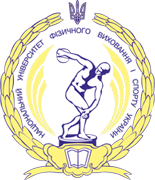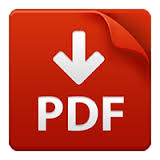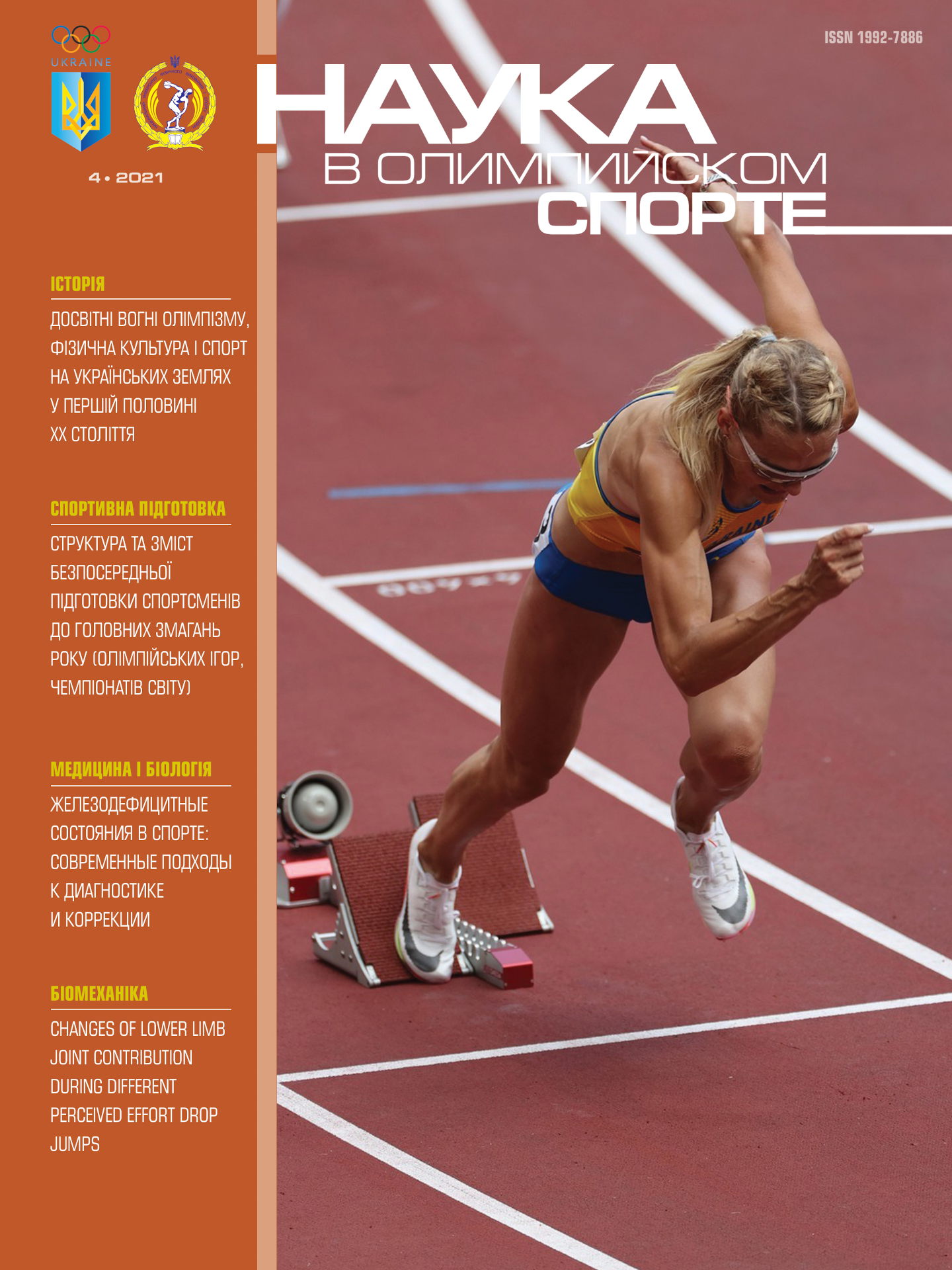Гунина Л, Рыбина И, Войтенко. В. Лабораторная диагностика перетренированности в спорте высших достижений. Наука в олимпийском спорте. 2021;3:16-25. DOI:10.32652/olympic2021.3_3
Мета. На основі аналізу і синтезу даних, наявних у науковій літературі, сформувати сучасні уявлення про можливості лабораторної діагностики та побудову діагностичного алгоритму виявлення й оцінювання вираженості синдрому перетренованості у висококваліфікованих спортсменів.
Методи. Аналіз і синтез наявних у сучасній науковій літературі результатів з досліджуваного питання, а також даних мережі Інтернет.
Результати. Представлено сучасні термінологічні характеристики перетренованості, підсумовано основні чинники, що призводять до розвитку даного синдрому у спортсменів, та описано алгоритми первинних і уточнюючих діагностичних технологій. Висвітлено найважливішу роль змін гормонального статусу спортсменів у формуванні недовідновлення і подальшого розвитку перетренованості, а також можливість використання розрахункових індексів для характеристики порушень анаболічного і катаболічного статусу спортсменів, які лежать в основі виникнення зазначених патологічних станів. Коротко описано найсучасніші методологічні підходи, що дозволяють проводити диференційне оцінювання перетренованості у спорті.
Висновок. Відсутність своєчасного діагностування даного синдрому призводить до погіршення стану здоров’я спортсмена. Основою своєчасної діагностики перетренованості повинні бути тести першого рівня: визначення вмісту сечовини, креатиніну, параметра середнього об’єму еритроцитів, а також активності креатинфосфокінази. Своєчасне використання показників порушення цілісності міоцитів, параметрів окисного стресу, вмісту прозапальних цитокінів та активності маркерних ферментів допоможе тренеру змінити структуру тренувального процесу і зберегти здоров’я спортсмена.
Література
1. Афанасьева ИА, Таймазов ВА. Синдром перетренированности у спортсменов: эндогенная интоксикация и факторы врожденного иммунитета [Overtraining syndrome in athletes: endogenous intoxication and factors of innate immunity]. Ученые записки университета имени П. Ф. Лесгафта. 2011;12(82):24-30.
2. Гунина ЛМ. Климато-часовая дезадаптация и фармакологические методы ее коррекции [Climatic and time zone disadaptation and pharmacological methods of its correction]. Научные труды НИИ физической культуры и спорта Республики Беларусь. 2013;12:123-5.
3. Ларин ОС, Гаврилов АН. Динамика биохимических маркеров на этапе трансформирующего мезоцикла тренировки в пауэрлифтинге [Dynamics of biochemical markers at the stage of transforming mesocycle of training in powerlifting]. Ученые записки университета имени П. Ф. Лесгафта. 2015;7(125):120-2. doi: 10.5930/issn.1994-4683.2015.07.125.p119-122.
4. Никулин БА, Родионова ИИ. Биохимический контроль в спорте [Biochemical control in sports]. Москва: Советский спорт; 2011. 232 с.
5. Платонов В. Перетренированность в спорте [Overtraining in sports]. Наука в олимпийском спорте. 2015;1:19-34.
6. Рыбина ИЛ, Гунина ЛМ. Лабораторные маркеры контроля и управления тренировочным процессом спортсменов: наука и практика [Laboratory markers of control and management of athletes’ training process: science and practice]. Москва: Спорт; 2021. 372 с.
7. Arakawa K, Hosono A, Shibata K, Ghadimi R, Fuku M, et al. Changes in blood biochemical markers before, during, and after a 2-day ultramarathon. Open Access J Sports Med. 2016;7:43-50. doi: 10.2147/OAJSM.S97468.
8. Balsalobre-Fernandez C, Tejero-Gonzalez CM, del Campo-Vecino J. Relationships between training load, salivary cortisol responses and performance during season training in middle and long distance runners. PLoS One. 2014;9(8):e106066. doi: 10.1371/journal.pone.0106066.
9. Batotsyrenova EG, Bakulev SE, Nevzorova TG, Ivanov MB, Kashuro VA, et al. Changes in the biorhythms of biochemical parameters in animals with modeled acute desynchronosis. Bull Exp Biol Med. 2020;170(2):191-5. doi: 10.1007/s10517-020-05030-1.
10. Bell L, Ruddock A, Maden-Wilkinson T, Rogerson D. Overreaching and overtraining in strength sports and resistance training: A scoping review. J Sports Sci. 2020;38(16):1897-1912. doi:10.1080/02640414.2020.1763077.
11. Borresen J, Lambert MI. The quantification of training load, the training response and the effect on performance. Sports Med. 2009;39(9):779-95. doi: 10.2165/11317780-000000000-00000.
12. Bouchard C, Shephard RJ, Stephens T. Physical activity; fitness and health: International proceedings and consensus statement. Champaign III: Human Kinetics; 1994. 356 p.
13. Bourdon PC, Cardinale M, Murray A, Gastin P, Kellmann M, et al. Monitoring athlete training loads: Consensus statement. Int J Sports Physiol Perform. 2017;12 (Suppl 2):S2161-70. doi: 10.1123/IJSPP.2017-0208.
14. Cadegiani FA, Kater CE. Hormonal aspects of overtraining syndrome: a systematic review. BMC Sports Sci Med Rehabil. 2017;9:14. doi: 10.1186/s13102-017-0079-8.
15. Cadegiani FA, Kater CE. Hormonal response to a non-exercise stress test in athletes with overtraining syndrome: results from the Endocrine and metabolic Responses on Overtraining Syndrome (EROS) − EROS-STRESS. J Sci Med Sport. 2018;21(7):648-53. doi: 10.1016/j.jsams.2017.10.033.
16. Carfagno DG, Hendrix JC. Overtraining syndrome in the athlete: current clinical practice. Curr Sports Med Rep. 2014;(13):45-51. doi: 10.1249/JSR.0000000000000027.
17. Castro-Sepulveda M, Cancino J, Fernandez-Verdejo R, Perez-Luco C, Jannas-Vela S, et al. Basal Serum Cortisol and Testosterone / Cortisol ratio are related to rate of Na+ lost during exercise in elite soccer players. Int J Sport Nutr Exerc Metab. 2019;29(6):658-63. doi: 10.1123/ijsnem.2019-0129.
18. Chan S, Debono M. Replication of cortisol circadian rhythm: new advances in hydrocortisone replacement therapy. Ther Adv Endocrinol Metab. 2010;1(3):129-38. doi: 10.1177/2042018810380214.
19. Clarkson PM, Kearns AK, Rouzier P, Rubin R, Thompson PD. Serum creatine kinase levels and renal function measures in exertional muscle damage. Med Sci Sports Exerc. 2006;38(4):623-37. doi: 10.1249/01.mss.0000210192.49210.fc.
20. Costello JT, Baker PR, Minett GM, Bieuzen F, Stewart IB, Bleakley C. Whole-body cryotherapy (extreme cold air exposure) for preventing and treating muscle soreness after exercise in adults. Cochrane Database Syst Rev. 2015;Sep18(9):CD010789. doi: 10.1002/14651858.CD010789.pub2.
21. Crewther BT, Obmiński Z, Cook CJ. Serum cortisol as a moderator of the relationship between serum testosterone and Olympic weightlifting performance in real and simulated competitions. Biol Sport. 2018;35(3):215-21. doi: 10.5114/biolsport.2018.74632.
22. da Rocha AL, Pinto AP, Kohama EB, Pauli JR, de Moura LP, et al. The proinflammatory effects of chronic excessive exercise. Cytokine. 2019;119:57-61. doi: 10.1016/j.cyto.2019.02.016.
23. da Silva Vasconcelos E, Salla RF. Resistance exercise, muscle damage and inflammatory response «what doesn’t kill you makes you stronger». MOJ Sports Medicine. 2018;2(2):65-7.
24. Dias SS, Weber MG, Padoin S, Andrello AC, Jussiani EI, de Paula Ramos S. Circulating concentration of chemical elements during exercise-induced muscle damage and the repeated bout effect. Biol Trace Elem Res. 2021; Apr 27. doi: 10.1007/s12011-021-02737-8. Online ahead of print. PMID: 33904125.
25. Djaoui L, Haddad M, Chamari K, Dellal A. Monitoring training load and fatigue in soccer players with physiological markers. Physiol Behav. 2017;181:86-94. doi: 10.1016/j.physbeh.2017.09.004.
26. Durkalec-Michalski K, Jeszka J, Podgorski T. The effect of a 12-week Beta-hydroxybetamethylbutyrate (HMB) supplementation on highly-trained combat sports athletes: A randomised, double-blind, placebo-controlled crossover study. Nutrients. 2017;9(7):753. doi: 10.3390/nu9070753.
27. Eicher ER. Overtraining: Consequences and prevention. J Sport Sci. 1994;(Spec N 13):41-3. doi: 10.1080/02640419508732276.
28. Feijen S, Tate A, Kuppens K, Barry LA, Struyf F. Monitoring the swimmer’s training load: A narrative review of monitoring strategies applied in research. Scand J Med Sci Sports. 2020;30(11):2037-43. doi: 10.1111/sms.13798.
29. Fitts RH, Widrick JJ. Muscle mechanics: adaptations with exercise-training. Exerc Sport Sci Rev. 1996;24:427-73.
30. Foster C, Rodriguez-Marroyo JA, de Koning JJ. Monitoring training loads: The past, the present, and the future. Int J Sports Physiol Perform. 2017;12(Suppl 2):S22-8. doi: 10.1123/ijspp.2016-0388.
31. Fry AC, Kraemer WJ, Stone MH, Koziris LP, Thrush JT, Fleck SJ. Relationships between serum testosterone, cortisol and weightlifting performance. J Strength Cond Res. 2000;14:338-43.
32. Fry AC, Schilling BK, Fleck SJ, Kraemer WJ. Relationships between competitive wrestling success and neuroendocrine responses. J Strength Cond Res. 2011;25(1):40-5. doi: 10.1519/JSC.0b013e3181fef62f.
33. Geisler S, Aussieker T, Paldauf S, Scholz S, Kurz M, et al. Salivary testosterone and cortisol concentrations after two different resistance training exercises. J Sports Med Phys Fitness. 2019;59(6):1030-5. doi: 10.23736/S0022-4707.18.08786-8.
34. Giordano R, Guaraldi F, Berardelli R, Karamouzis I, D’Angelo V, et al. Glucose metabolism in patients with subclinical Cushing’s syndrome. Endocrine. 2012;41(3):415-23. doi: 10.1007/s12020-012-9628-9.
35. Gorostiaga EM, Grandados C, Ibanez J, Gonzalez-Badillo JJ, Izquierdo M. Effects of an entire season on physical fitness changes in elite male handball players. Med Sci Sports Exercise. 2006;38:357-66. doi: 10.1249/01.mss.0000184586.74398.03.
36. Guemes M, Rahman SA, Hussain K. What is a normal blood glucose? Arch Dis Child. 2016;101(6):569-74. doi: 10.1136/archdischild-2015-308336.
37. Halson SL. Monitoring training load to understand fatigue in athletes. Sports Med. 2014;44(Suppl 2):S139-47. doi: 10.1007/s40279-014-0253-z.
38. Harber M, Trappe S. Single muscle fiber contractile properties of young competitive distance runners. J Appl Physiol (1985). 2008;105(2):629-36. doi: 10.1152/japplphysiol.00995.2007.
39. Hayes LD, Bickerstaff GF, Baker JS. Interactions of cortisol, testosterone, and resistance training: influence of circadian rhythms. Chronobiol Int. 2010;27(4):675-705. doi: 10.3109/07420521003778773.
40. Hazar M, Otag A, Otag I, Sezen M, Sever O. Effect of increasing maximal aerobic exercise on serum muscles enzymes in professional field hockey players. Glob J Health Sci. 2014;7(3):69-74. doi: 10.5539/gjhs.v7n3p69.
41. Hooper DR, Tenforde AS, Hackney AC. Treating exercise-associated low testosterone and its related symptoms. Phys Sportsmed. 2018;46(4):427-34. doi: 10.1080/00913847.2018.1507234.
42. Hu YC, Chu KF, Hwang LY, Lee TH. Cortisol regulation of Na(+), K(+)-ATPase beta1 subunit transcription via the pre-receptor 11beta-hydroxysteroid dehydrogenase 1-like (11beta-Hsd1L) in gills of hypothermal freshwater milkfish, Chanos chanos. J Steroid Biochem Mol Biol. 2019;192:105381. doi: 10.1016/j.jsbmb.2019.105381.
43. Jones TW, Howatson G, Russell M, French DN. Effects of strength and endurance exercise order on endocrine responses to concurrent training. Eur J Sport Sci. 2017;17(3):326-34. doi: 10.1080/17461391.2016.1236148.
44. Khaitin V, Bezuglov E, Lazarev A, Matveev S, Ivanova O, et al. Markers of muscle damage and strength performance in professional football (soccer) players during the competitive period. Ann Transl Med. 2021;9(2):113. doi: 10.21037/atm-20-2923.
45. Knopfli B, Calvert R, Bar-Or O, Villiger B, Von Duvillard SP. Competition performance and basal nocturnal catecholamine excretion in cross-country skiers. Med Sci Sports Exerc. 2001Jul;33(7):1228-32. doi: 10.1097/00005768-200107000-00023.
46. Koch AJ, Pereira R, Machado M. The creatine kinase response to resistance exercise. J Musculoskelet Neuronal Interact. 2014;14(1):68-77.
47. Kraemer WJ, French DN, Paxton NJ, Hakkinen K, Volek JS, et al. Changes in exercise performance and hormonal concentrations over a big ten soccer season in starters and nonstarters. J Strength Cond Res. 2004;18(1):121-8. doi: 10.1519/1533-4287(2004)018<0121:ciepah>2.0.co;2.
48. Kraemer WJ, Ratamess NA, Hymer WC, Nindl BC, Fragala MS. Growth hormone(s), Testosterone, Insulin-Like Growth Factors, and Cortisol: Roles and integration for cellular development and growth with Exercise. Front Endocrinol (Lausanne). 2020;11:Art. 33. doi: 10.3389/fendo.2020.00033.
49. Lee EC, Fragala MS, Kavouras SA, Queen RM, Pryor JL, Casa DJ. Biomarkers in sports and exercise: tracking health, performance, and recovery in athletes. J Strength Cond Res. 2017;31(10):2920-37. doi: 10.1519/JSC.0000000000002122.
50. Lehmann M, Baumgartl P, Wiesenack C, Seidel A, Baumann H, et al. Training-overtraining: influence of a defined increase in training volume vs training intensity on performance, catecholamines and some metabolic parameters in experienced
middle- and long-distance runners. Eur J Appl Physiol Occup Physiol. 1992;64(2):169-77. doi: 10.1007/BF00717956.
51. Lehmann M, Dickhuth HH, Gendrisch G, Lazar W, Thum M, et al. Training-overtraining. A prospective, experimental study with experienced middle- and long-distance runners. Int J Sports Med. 1991;12(5):444-52.
52. Machado AF, Almeida AC, Micheletti JK, Vanderlei FM, Tribst MF, et al. Dosages of cold-water immersion post exercise on functional and clinical responses: a randomized controlled trial. Scand J Med Sci Sports. 2017;27(11):1356-63. doi: 10.1111/sms.12734.
53. Maestu J, Eliakim A, Jurimae J, Valter I, Jurimae T. Anabolic and catabolic hormones and energy balance of the male bodybuilders during the preparation for the competition. J Strength Cond Res. 2010;24(4):1074-81. doi: 10.1519/JSC.0b013e3181cb6fd3.
54. Main LC, Dawson B, Heel K, Grove JR, Landers GJ, Goodman C. Relationship between inflammatory cytokines and self-report measures of training overload. Res Sports Med. 2010;18(2):127-39. doi: 10.1080/15438621003627133.
55. Malisoux L, Francaux M, Nielens H, Theisen D. Stretch-shortening cycle exercises: an effective training paradigm to enhance power output of human single muscle fibers. J Appl Physiol. (1985). 2006;100(3):771-9. doi: 10.1152/japplphysiol.01027.2005.
56. Marin DP, Bolin AP, Campoio TR, Guerra BA, Otton R. Oxidative stress and antioxidant status response of handball athletes: implications for sport training monitoring. Int Immunopharmacol. 2013;17(2):462-70. doi: 10.1016/j.intimp.2013.07.009.
57. McGuigan MR, Egan AD, Foster C. Salivary cortisol responses and perceived exertion during high intensity and low intensity bouts of resistance exercise. J Sports Sci Med. 2004;3(1):8-15. PMID: 24497815.
58. Meeusen R, Duclos M, Foster C, Fry A, Gleeson M, et al. Prevention, diagnosis, and treatment of the overtraining syndrome: joint consensus statement of the European College of Sport Science and the American College of Sports Medicine. Med Sci Sports Exerc. 2013;45(1):186-205. doi: 10.1249/MSS.0b013e318279a10a.
59. Mougios V. Exercise biochemistry. Champaign, Illinois, USA: Human Kinetics; 2006. 296 р.
60. Nelson D, Cox M. In: Fundamentals of biochemistry lehninger: Volume 2: Bioenergetics and metabolism. Moscow, Binom, Knowledge Laboratory, 2014;318-29.
61. Nowakowska A, Kostrzewa-Nowak D, Buryta R, Nowak R. Blood biomarkers of recovery efficiency in soccer players. Int J Environ Res Public Health. 2019; 16(18):3279-3307. doi: 10.3390/ijerph16183279.
62. Palacios G, Pedrero-Chamizo R, Palacios N, Maroto-Sanchez B, Aznar S, et al. EXERNET Study Group. Biomarkers of physical activity and exercise. Nutr Hosp. 2015;31(Suppl 3):237-44. doi: 10.3305/nh.2015.31.sup3.8771.
63. Pasiakos SM, Lieberman HR, McLellan TM. Effects of protein supplements on muscle damage, soreness and recovery of muscle function and physical performance: a systematic review. Sports Med. 2014;44(5):655-70. doi: 10.1007/s40279-013-0137-7.
64. Patterson S, Moran P, Epel E, Sinclair E, Kemeny ME, et al. Cortisol patterns are associated with T cell activation in HIV. PLoS One. 2013;26:8(7):e63429. doi: 10.1371/journal.pone.0063429.
65. Pedlar CR, Newell J, Lewis NA. Blood biomarker profiling and monitoring for high-performance physiology and nutrition: Current perspectives, limitations and recommendations. Sports Med. 2019;49(Suppl 2):185-98. doi: 10.1007/s40279-019-01158-x.
66. Petibois C, Cazorla G, Poortmans JR, Deleris G. Biochemical aspects of overtraining in endurance sports: a review. Sports Med. 2002;32(13):867-78. doi: 10.2165/00007256-200232130-00005.
67. Petry L, Kippenberger S, Meissner M, Kleemann J, Kaufmann R, et al. Directing adiposederived stem cells into keratinocyte-like cells: impact of medium composition and culture condition. J Eur Acad Dermatol Venereol. 2018;32(11):2010-9. doi: 10.1111/jdv.15010.
68. Pondeljak N, Lugović-Mihić L. Stress-induced interaction of skin immune cells, hormones, and neurotransmitters. Clin Ther. 2020;42(5):757-70. doi: 10.1016/j.clinthera.2020.03.008.
69. Raeder C, Wiewelhove T, Simola RA, Kellmann M, Meyer T, et al. Assessment of fatigue and recovery in male and female athletes after 6 days of intensified strength training. J Strength Cond Res. 2016;30(12):3412-27. doi: 10.1519/JSC.0000000000001427.
70. Richardson SO, Anderson MB, Morris T. Overtraining athletes: Personal journeys in Sport. Human Kinetics; 2008. 205 p.
71. Rodrigues BM, Dantas E, de Salles BF, Miranda H, Koch AJ, et al. Creatine kinase and lactate dehydrogenase responses after upper-body resistance exercise with different rest intervals. J Strength Cond Res. 2010;24(6):1657-62. doi: 10.1519/JSC.0b013e3181d8e6b1.
72. Rusko H, Bosco C, Komulainen J, Leinonen A, Vihko V. Muscle enzyme adaptations to added load during training and nontraining hours in rats. J Appl Physiol. (1985). 1991;70(2):764-9. doi: 10.1152/jappl.1991.70.2.764.
73. Shields GS, Ivory SL, Telzer EH. Three-month cumulative exposure to testosterone and cortisol predicts distinct effects on response inhibition and risky decision-making in adolescents. Psychoneuroendocrinology. 2019;110:104412. doi: 10.1016/j.psyneuen.2019.104412.
74. Smith L. Cytokine hypothesis of overtraining: a physiological adaptation to excessive stress? Med Sci Sports Exe. 2000;32(2):317-31. doi: 10.1097/00005768-200002000-00011.
75. Storey A, Smith HK. Unique aspects of competitive weightlifting: performance, training and physiology. Sports Med. 2012;42(9):769-90. doi: 10.1007/BF03262294.
76. Testai FD, Gorelick PD. Inherited metabolic disorders and stroke. Part 2: homocystinuria, organic acidurias, and urea cycle disorders. Arch Neurol. 2010;67(2):148-53. doi: 10.1001/archneurol.2009.333.
77. Trappe S, Harber M, Creer A, Gallagher P, Slivka D, et al. Single muscle fiber adaptations with marathon training. J Appl Physiol (1985). 2006;101(3):721-7. doi: 10.1152/japplphysiol.01595.2005.
78. Urhausen A, Gabriel H, Kindermann W. Blood hormones as markers of training stress and overtraining. Sports Med. 1995;20(4):251-76. doi: 10.2165/00007256-199520040-00004.
79. Van Hooren B, Peake JM. Do we need a cool-down after exercise? A narrative review of the psychophysiological effects and the effects on performance, Injuries and the long-term adaptive Response. Sports Med. 2018;48(7):1575-95. doi: 10.1007/s40279-018-0916-2.
80. Vanrenterghem J, Nedergaard NJ, Robinson MA, Drust B. Training load monitoring in team sports: A novel framework separating physiological and biomechanical loadadaptation pathways. Sports Med. 2017;47(11):2135-42. doi: 10.1007/s40279-017-0714-2.
81. Warren JD, Blumbergs PC, Thompson PD. Rhabdomyolysis: a review. Muscle Nerve. 2002;25(3):332-47. doi: 10.1002/mus.10053.
82. Weerapong P, Hume PA, Kolt GS. The mechanisms of massage and effects on performance, muscle recovery and injury prevention. Sports Med. 2005;35(3):235-56. doi: 10.2165/00007256-200535030-00004.
83. Wiewelhove T, Raeder C, Meyer T, Kellmann M, Pfeiffer M, Ferrauti A. Markers for routine assessment of fatigue and recovery in male and female team sport athletes during high-intensity interval training. PLoS One. 2015;10(10):e0139801. doi: 10.1371/journal.pone.0139801.
Надійшла 11.10.2021













